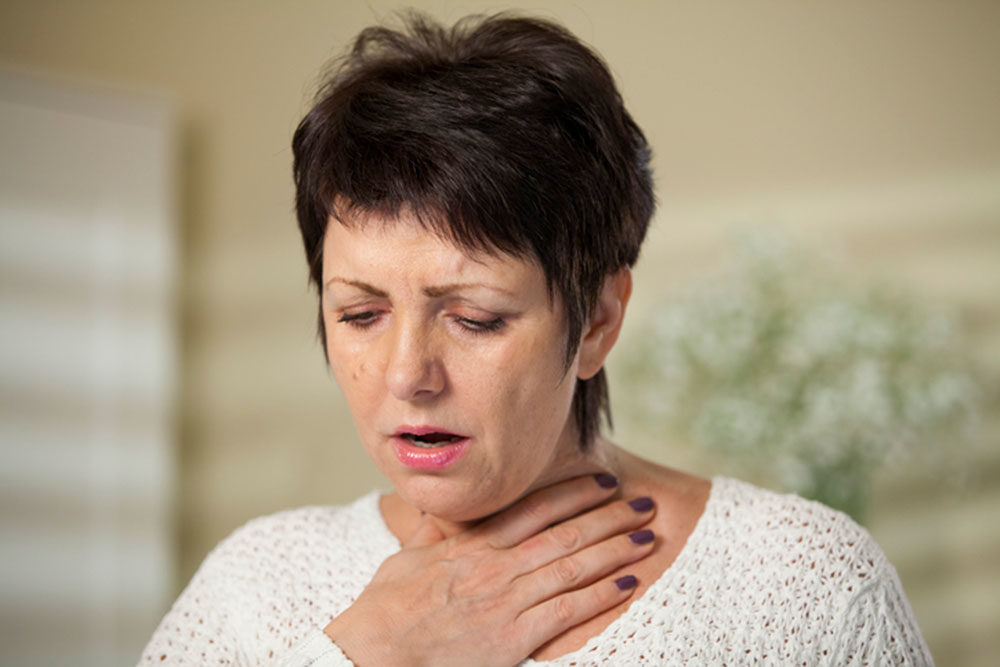
iStock
SHORTNESS of breath, or dyspnea, both feels unpleasant and can cause low-energy levels. It can signal asthma or more serious lung or heart disease. Or you could be short of breath due to anemia, low blood pressure, too-tight clothes—or, most commonly, anxiety.
Before rushing to the doctor, you can find relief in simple relaxation and breathing techniques. To ease airways by relaxing the neck and shoulders, sit in a chair with elbows resting on knees or chin in hands. Or stand near a wall with hips resting against the wall, body leaning slightly forward and arms dangling. Correcting the position or angle of the head on the neck can also help relax these muscles.
The key to better breathing is the exhale: longer exhales make more room for incoming air and slow the breath to give lungs more time to absorb oxygen before the next round. And slowing the breath—the only function of the autonomic nervous system that can be controlled—has a relaxing effect throughout the entire body, for example, lowering the heart rate.
During exercise, you can ease breathing by exhaling through the mouth with lips pursed (shaped as if for whistling) and inhaling through the nose. Count two for the in-breath and four when breathing out, as slowly as possible.
In general, though, strenuous exercise is the only good reason for mouth breathing, because it speeds the transport of oxygen to the muscles. The downsides include less oxygen in the blood to supply crucial organs—and shallower breathing, the most common respiratory dysfunction.
Inhalation through the nose warms, moistens and conditions the air. The nose offers other advantages, notably via its production of nitric oxide (NO)– dubbed a “pleasant poison” because it’s also an air-pollutant. Released continuously by the nasal passages into inhaled air, NO dilates the airways and blood vessels to improve both the lungs’ ability to absorb oxygen and the transport of oxygen throughout the body. It also kills bacteria.
Exhaling through the nose can slow the breath by more than 50%, resulting in an intake by the lungs of 10 to 20% more oxygen.
The combination of slow in-breath and slower out-breath is the basis of diaphragmatic breathing, also called belly breathing. While sitting relaxed or lying flat, place one hand on the abdomen to feel it expand with the in-breath and empty when breathing out. Diaphragmatic breathing for 5 to 10 minutes daily can change long-established poor breathing habits, especially shallow breathing—which over time damages the lungs.
“Shallow breathing is what we do when we literally hide from a predator…and when we feel like we want to hide,” writes Paul Ingraham on PainScience. “Deep breathing is one of the main practical suggestions for fighting anxiety. It’s a feedback loop.” Deeper breathing is a balm to anxious feelings, which in turn makes it easier to breathe more deeply.
In addition to decreasing anxiety and improving relaxation, changing the breathing patterns can counter depression and nausea, and improve attention and confidence.
“Air hunger,” the shortness of breath most often associated with anxiety, is a feeling—but not a physical problem—that insufficient air is being taken in. “Effort” is the sensation of needing extra work to breathe and is most often associated with COPD (chronic obstructive pulmonary disease).
“Tightness,” a feeling that the airways are constructed, could be due to muscle pain but often occurs in the early stages of asthma attacks—when airways narrow, swell and produce extra mucus. Asthma is the most common reason for emergency room visits due to shortness of breath and affects about 5% of the population.
Besides asthmatic wheezing, shortness-of-breath symptoms that can require medical attention include acute dyspnea—developing suddenly over hours to days; fever or chills; fast-fluttering heartbeats; swelling in feet and ankles; trouble breathing while lying flat (orthnopnea, usually an indication of heart problems); and worsening of breathing problems that interfere with regular daily activities.
Shortness of breath can also be a sign of pneumonia. The lungs can also be affected by HAPE (High-Altitude Pulmonary Edema) that occurs two to four days after ascending quickly to altitudes over 8,000 feet. HAPE causes a cough and fatigue as well as dyspnea that begins with exertion and may progress to dyspnea at rest.
For breathing complaints, a simple test uses a “pulse-ox” (pulse-oximeter), a sensor placed on the finger that employs light to measure the amount of oxygen in the blood. Another device is the spirometer, a mouthpiece connected to a machine—you take a deep breath and blow out as hard as you can—that measures lung capacity and air flow.
An electrocardiogram (EKG) uses electrodes attached to the chest to measure electrical impulses that signal the heart to beat. The EKG can detect heart problems, such as a weakened heart muscle that cannot pump enough blood to meet the body’s needs for blood and oxygen. And chest x-rays can show signs of pneumonia as well as other serious lung problems such as COPD, which affects 90% of American smokers, or a pulmonary embolism (clot).
Medical devices can also help treat shortness of breath. For CART (Capnometry-Assisted Respiratory Training), a capnometer gives feedback on CO2 levels with the goal of reducing hyperventilation, which causes low CO2 and panic symptoms. For treating asthma, inhalers and bronchodilators deliver medication that helps open the airways.
Shallow breathing over time causes the lungs to weaken and stiffen, making deep breathing another use-it or lose-it bodily function. Deepening the breath by slowing it down can thus stave off long-term health problems as well as counter anxiety and improve energy and relaxation throughout the day.
—Mary Carpenter
Every Tuesday in this space, well-being editor Mary Carpenter reports on health news that affects our everyday lives.
